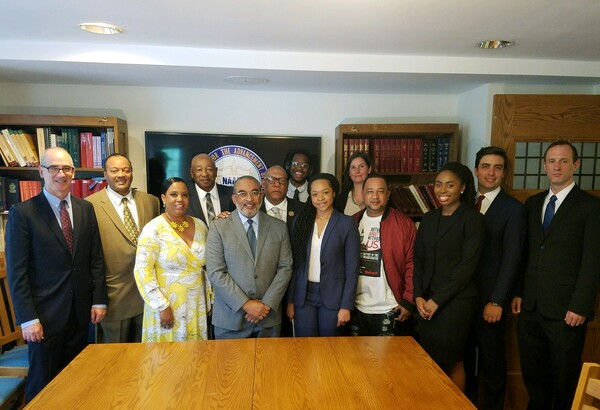[Caption: Members of the Rule of Law Clinic and the NAACP at a press conference on June 28, 2018, announcing the lawsuit. Those pictured include Professor Mike Wishnie ’93, Brad Berry ’88, NAACP General Counsel, Clinical Lecturer in Law Hope Metcalf, Ashley Hall ’19, Keturah James ’19, Rich Medina ’18, and John Super ’20.]
On June 28, 2018, the clinic filed suit in federal court on behalf of the National Association for the Advancement of Colored People (NAACP), the NAACP Connecticut State Conference, and five Connecticut residents to compel the State of Connecticut to adopt a new redistricting map that counts prisoners in their home state legislative districts rather than in the districts where they are being incarcerated, thereby safeguarding the Fourteenth Amendment principle of “one person, one vote”. The NAACP is co-counsel on the suit.
By law, Connecticut is divided up into a number of districts with equal population—and each district elects one representative to send to the Connecticut State Legislature. The law requires each district to have equal population because having more people in one district dilutes the value of their individual votes and puts those residents at a disadvantage in competing for their representative’s time and attention. Conversely, having fewer people in a district gives voters there an advantage—the value of their own vote is inflated, and their legislator can do a better job in representing them because she has fewer constituents to represent.
But for purposes of drawing legislative maps, Connecticut counts incarcerated persons at the location of their prison, not their pre-incarceration addresses. This process is called “prison gerrymandering.” Disproportionately, these prisoners come from urban centers like New Haven, Bridgeport, and Hartford, and Connecticut puts them in prison in rural areas like Enfield and Somers. This means that instead of their hometown representatives, prisoners must rely on representatives from those areas where prisons are located to protect their interests in the State Legislature—something that is unlikely to happen. By contrast, their home representatives—where prisoners’ families are—carry the de facto responsibility of representing their interests. Counting disenfranchised prisoners where they are confined instead of at their home address inflates the voices of rural, white residents at the expense of predominantly minority residents in overpopulated urban districts.
The state moved to dismiss the action, and on February 19, 2019, Judge Warren Eginton denied the motion, holding that the case can proceed to discovery and trial. The state filed an unusual interlocutory appeal to the Second Circuit and asked Judge Eginton to stay all further proceedings in the district court. On May 8, 2019, the Court denied the request, concluding that, "[F]or purposes of considering whether a stay should issue under the dual jurisdiction rule, the Court finds that defendants' appeal on the basis of the Eleventh Amendment is frivolous."
The state’s appeal was argued before the U.S. Court of Appeals for the Second Circuit on September 10, 2019. On September 24, the Court unanimously affirmed the district court’s refusal to dismiss the action, holding that the case could move forward. The Second Circuit also directed that on remand the case should be referred to a three-judge district court appointed by the Chief Judge of the Second Circuit.
Public Documents
Complaint, NAACP v. Merrill, No. 3:18-cv-01094 (filed June 28, 2018)
Opinion & Order Denying Motion to Stay
Opinion & Order Denying Motion to Dismiss
Plaintiffs’ Opposition to Motion to Dismiss
ROLC Student Ashley Hall's Testimony Before the CT Government Administration & Elections Committee in Support of H.B. 5611 to End Prison Gerrymandering in CT (3:02:23 - 3:11:00) (February 15, 2019)
Order Affirming in Part District Court's Order
Prison Gerrymandering Factsheet
Expert Report: William S. Cooper
Plan A Map
Press
Connecticut Could Pass Bill For More Equitable Counting Of Prison Inmates, WSHU Public Radio, (March 30, 2021)
Committee Forwards Prison Gerrymandering Bill To Senate, CT News Junkie (March 29, 2021)
Opinion: State must end prison gerrymandering, CT Post (March 18, 2021)
Bill aimed at ending ‘prison gerrymandering’ approved in committee, CT Post (March 29, 2021)
Committee Takes On Prison Gerrymandering, CT News Junkie (March 11, 2021)
Bill Would Change How Inmates Are Counted For Redistricting, Associated Press (March 10, 2021)
Advocates Look To End Prison Gerrymandering In Connecticut, WSHU Public Radio, (March 10, 2021)
Prison Gerrymandering Suit Can Proceed, New Haven Independent (September 24, 2019)
Judge Allows Prison Gerrymandering Lawsuit to Move Forward, NBC Connecticut (February 21, 2019)
Prison Gerrymandering Lawsuit Moves Forward in Connecticut, Courthouse News (February 20, 2019)
NAACP Wins First Battle in Lawsuit to End Prison Gerrymandering in CT, The Crime Report (February 20, 2019)
Lawmakers Take Up Bills to Strengthen Felons' Voting Rights, Change Inmate Count Practice, The CT Mirror (February 15, 2019)
Prison Gerrymandering Challenged in Connecticut Lawsuit, Between the Lines (January 16, 2019)
Counting Prison Inmates Differently Could Shift Political Power to Cities, Pew Stateline (January 2, 2019)
Prison Gerrymandering, New York Law Journal (January 2, 2019)
ROLC, NAACP Sue Connecticut Over Prison Gerrymandering, Yale Law School (June 28, 2018)
Editorial: Connecticut should end practice of ‘prison gerrymandering,’ New Haven Register (July 15, 2018)
Markeshia Ricks, NAACP Sues State For “Prison Gerrymandering, New Haven Independent (June 28, 2018)
Mary E. O'Leary, NAACP, Yale Law sue state over ‘prison gerrymandering’, New Haven Register (June 28, 2018)
NAACP Sues To Throw Out Connecticut Legislature’s Map Over Prison Gerrymandering, Huffington Post (June 28, 2018)
NAACP Sues Connecticut Over 'Prison Gerrymandering,' Hartford Courant (June 28, 2018)
NAACP sues Connecticut over 'prison gerrymandering,' The Guardian (June 28, 2018)
How Prison Gerrymandering Strips Power from Communities of Color, In These Times (August 16, 2018)
Prison Gerrymandering Must End in Connecticut, Connecticut Law Tribune (February 7, 2020)

